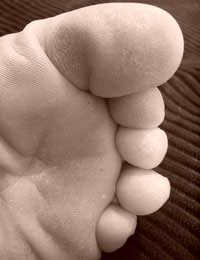Calluses

The term callus is given to an area of hardened skin that has become toughened over time due to repeated friction and pressure to the area. These areas are usually found on the toes, feet and sometimes hands. They are not serious or particularly detrimental to overall health but can cause significant discomfort to the person, or if left untreated can carry the possibility of leading to an infection developing.
Why do Calluses form?
The usual cause of a callus forming is due to constant pressure to the area or from continual rubbing and friction. When a callus develops on the foot it is usually because of ill-fitting shoes, or if found on the sole of the foot, because of spending too much time doing lots of physical activity such as long distance running, hiking or even dancing barefoot.Sometimes socks can be blamed for calluses, as the seams may rub or become trapped between the toes beginning the process of areas of friction and redness occurring.Very rarely a callus may be a side effect of another illness such as syphilis or because of a reaction to some substances that can cause the tissues to thicken and harden.
Signs and Symptoms
Calluses often begin with a reddened area that is painful, usually from shoes that rub. If the same shoes are worn continually, a callus can grow. In their early stages of development, they may feel as though they are burning or throbbing, but as it ages and grows, it often becomes less acutely painful, but the increase in size can lead to the wearing of many different types of shoes uncomfortable.Calluses vary in size and shape from person to person and can be yellow, white or even greyish in colour.Treatment for Calluses
Many people find that moisturising creams that aim to soften the tissue, along with a gentle exfoliating device such as a pumice stone, are enough to keep their calluses at bay and can help reduce them if they grow too large.Softening the area in warm water before exfoliation will help to soften the skin and allow for easier removal of the tissue.Most chemists and supermarkets stock a selection of cushioning plasters that can be worn over the affected area to prevent further friction from causing pain or worsening the callus.If these options do not improve the callus, it may need treatment from a professional. An appointment with a qualified chiropodist will allow for assessment of the calluses so that appropriate treatment can be sought. It may be that the area needs shaving, which must never be attempted at home as specialist and sterile equipment should be used to prevent trauma or infection.If infection does occur, seek advice from your GP as anti-biotics may be needed.
Preventing Calluses
The easiest way to prevent a callus is to ensure that comfortable footwear is chosen, good quality leather is recommended, shoes that can expand as the feet get hot and swell such as those with laces or Velcro fastenings and by choosing cotton socks that fit correctly and are soft and flexible with movement.Always choose trainers or sports shoes that are appropriate to the activity and ensure that they fit correctly.Although they are not serious, calluses can cause a lot of discomfort for the sufferer and can be very unsightly. They can be treated very easily and in most cases will not cause long-term problems for the person.
- Walking Aids: Braces & Splints
- Minimising Foot Swelling During Pregnancy
- How to Minimise the Risk of Blisters
- Combating Sweaty Feet
- Shin Splint Pain and Treatment
- Improving Heel Fissures
- What Are Heel Spurs?
- Peripheral Edema: Swelling in the Feet and Legs
- Webbed Toes and Treatment
- Fractured Calcanium
- Chilblains and Feet
- Bunions
- Corns: the Causes and Treatments
- In-growing Toenails
- Athlete's Foot
- Blisters
- Verrucas


Re: Footcare and the Housebound
My dad is housebound due to 5 major strokes. He walks with a walker and wears a foot splint. The splint is old, heavy and no longer…
Re: Supportive Feet Products for Senior Citizens
I have a prescription from Dr. at OHSU, but I need some lab to make the Orthodic insoles for my shoes. I was…
Re: How to Get into Foot Modelling
I am female 32yrs of age.I am from south africa I would like to enter into feet and hands modelling industry .I know and I…
Re: The Benefits of a Paraffin Wax Treatment
Hi! Does it cure sweaty palm and feet too?
Re: I have Sharp Pains in My Foot, What could it be?
Recently I have been experiencing a stabbing pain in my left foot,its on the bottom at the back. When I…
Re: Fungal Infections of the Foot and Toenail
I have a constant problem with intense itching on my feet which erupts daily, especially when my feet get warm…
Re: Cosmetic Foot Surgery
I have extremely sweaty feet and it seems to be getting worse. I have perspirex, but it doesnt help. Please help, I don't know what to do…
Re: The Benefits of Foot Massage for Children
One day I came home and my wife said our younger son was having trouble concentrating on his homework. I asked…
Re: Cavus Feet: Symptoms, Causes and Treatments
@sue - I am sorry to hear this. As suggested in the article, arch supports or orthotic devices may be used to…
Re: Cavus Feet: Symptoms, Causes and Treatments
My daughter has cavus feet and has had surgery a few times already. Her surgeon has dismissed her and she is…